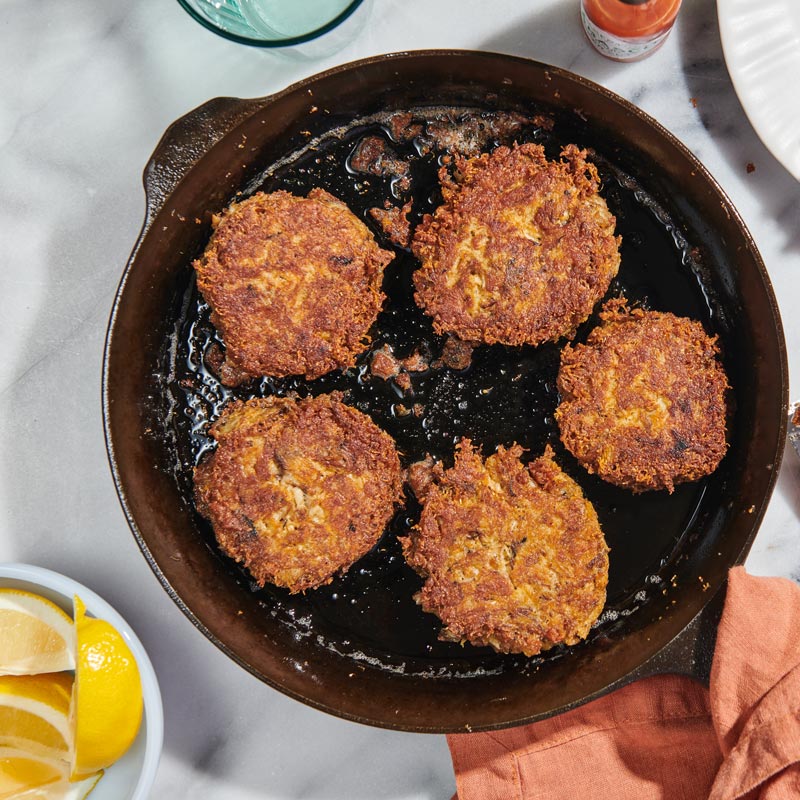You can cook just about anything in a cast iron pan, but ever since we started using our Field Skillets, making perfect paella in cast iron has been our white whale. It’s not for a lack of trying: We’ve made several serviceable paellas in our skillets over the years, but have never been able to achieve that layer of crisp, caramelized rice (called socarrat) at the bottom of the pan that makes the dish memorable. It makes perfect sense why: Field Skillets are naturally nonstick, while traditional paella pans are made from aluminum or carbon steel, to which rice easily adheres.

While our quest to make perfect paella in cast iron is still very much in progress, we’ve been making the Spanish showstopper’s cousin, fideuà, any time we’re craving Spanish flavors in a quick, one-skillet meal. This Valencian dish calls for fideos (short, spaghetti-like “noodles”) to be toasted in a skillet, then simmered in seafood broth along with tomatoes and various fish and shellfish.
Here, cast iron’s superior heat retention and nonstick qualities are an asset, and we’re constantly tinkering with the seasonings and add-ins as the season and mood fits—but we always finish the dish with lemon wedges and dollops of garlicky aioli.
We’ll report back once we crack the cast iron paella code; until then, take our fideuà recipe and tweak it to your liking.
Field Notes
If you can’t find fideo noodles at your grocery store, there’s no need hunting it down at a specialty shop or online. Buy some spaghetti and break it into small pieces, roughly 1 inch in length.
If you have the time, using homemade seafood stock and allioli (Spanish-style garlic aioli) will make this dish even better. Here's a primer on making shellfish stock, and one for allioli.
Worried about cooking tomatoes in cast iron? Don’t! While cooking acidic foods in a cast iron skillet for extended amounts of time can degrade its seasoning, our recipe calls for a relatively brief simmer in liquid that has a relatively neutral pH. If anything, toasting the fideos in a generous amount of oil will only improve your skillet’s seasoning.
Our fideuà recipe below is close to the traditional Valencian style, but we frequently swap in other kinds of fish and shellfish, or add paella turista flavors (chorizo, chicken, saffron) when we’re in the mood.
Recipe: Cast Iron Skillet Fideuà with Shellfish
Ingredients
½ cup extra-virgin olive oil, divided
18 large shrimp (about 1 pound), peeled and deveined
1 pound fideo noodles, or 1 pound spaghetti, broken into 1-inch pieces
1 small onion, finely chopped
5 garlic cloves, finely chopped
1 teaspoon smoked paprika
4 cups fish or shellfish stock (preferably homemade)
1½ cups crushed tomatoes
18 clams and/or mussels, scrubbed
¼ cup chopped parsley
Allioli (garlic aioli), for serving
Lemon wedges, for serving
Tools
with No.12 Cast Iron Lid
Resources
The Field Method for Cast Iron Care
Instructions
Heat a No.12 Field Skillet over medium-heat high. Add 2 tablespoons of olive oil. When the oil shimmers, add the shrimp and cook for 1 minute per side. Transfer to a plate.
Add 3 tablespoons of olive oil to the pan and stir in the pasta. Cook, stirring frequently, until the pasta is toasted and golden brown, about 5 minutes. Transfer the pasta to a plate.
Lower the heat to medium and add the remaining 3 tablespoons of olive oil to the skillet. Add the onion and garlic and cook, stirring, until softened and lightly browned, 4 to 5 minutes. Stir in the paprika and cook for 30 seconds. Add 3 cups of fish stock and the tomatoes, bring to a boil, and cook until the liquid is reduced slightly, about 5 minutes. Season the broth to taste with salt.
Add the pasta to the pan, return the liquid to a simmer, and cook, stirring and pressing down on the noodles occasionally, until the noodles are softened but still have a bit of crunch, 5 to 7 minutes. The braising liquid should be thickened and almost jammy; if the mixture dries out, add more fish stock as needed.
Scatter the clams and mussels over the pasta, then cover the skillet and cook until the shells open, 3 to 4 minutes. Discard any clams or mussels that don’t open. Scatter the shrimp over the pasta, cover the skillet again, and let sit for 5 minutes.
Sprinkle the parsley over the fideuà. Divide the fideuà among shallow bowls and serve with allioli and lemon wedges on the side.




